PPMP20009 - Lean Project Management Implementation in FIFA World Cup
VerifiedAdded on 2023/06/07
|17
|3608
|338
Report
AI Summary
This report provides an analysis of implementing lean project management strategies for the FIFA World Cup, focusing on enhancing efficiency and meeting customer expectations. It identifies the voice of the customer (VOC), critical customer requirements (CCR), and critical to quality (CTQ) parameters. The report details the application of lean principles, including value stream mapping, process flow management, and continuous improvement. Furthermore, it explores how methodologies such as PMBOK (Project Management Body of Knowledge) and PRINCE2 can support lean project implementation, emphasizing process initiation, planning, execution, monitoring, and closure to ensure successful event management and stakeholder satisfaction. Desklib offers a range of similar solved assignments and past papers for students.
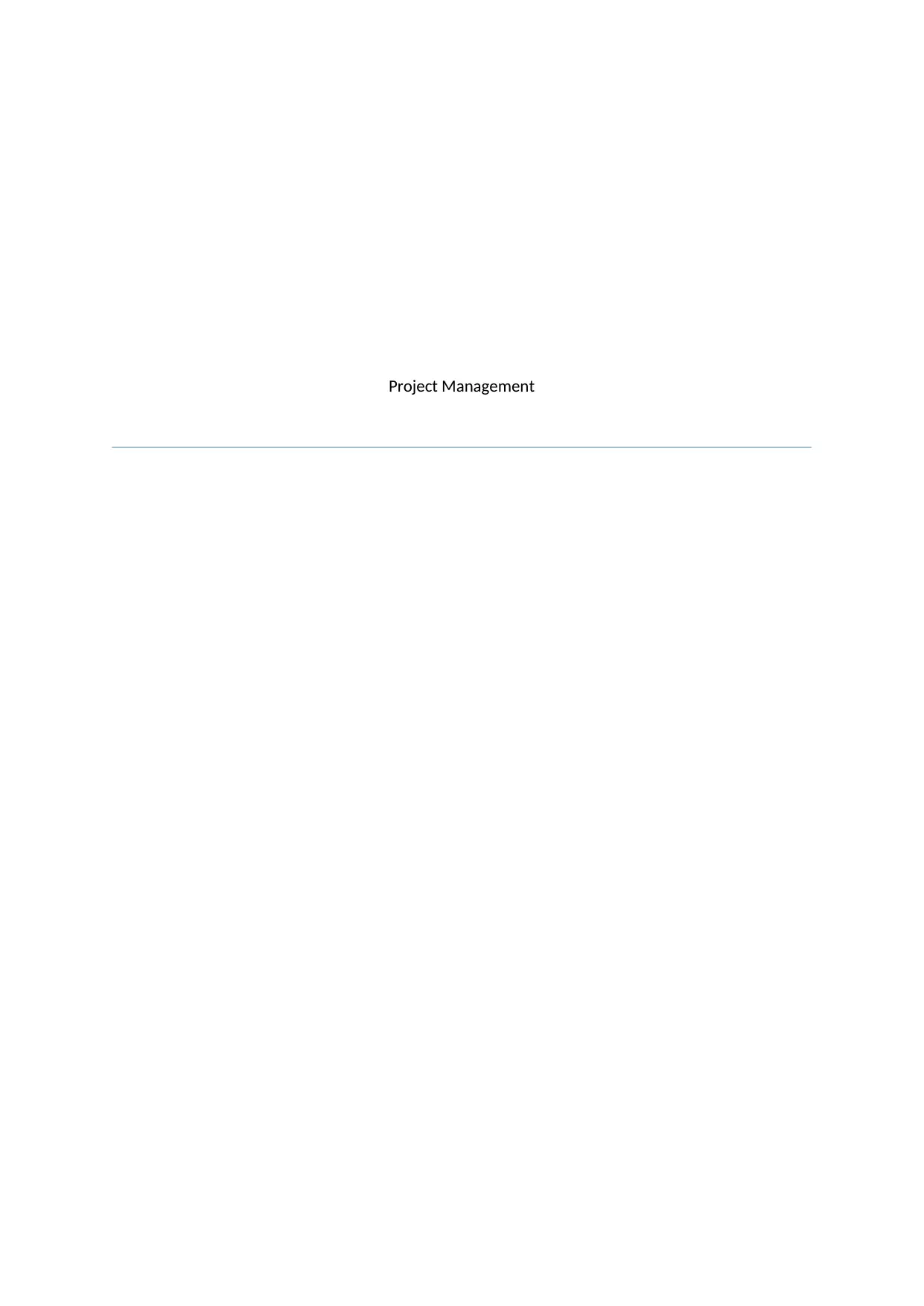
Project Management
Paraphrase This Document
Need a fresh take? Get an instant paraphrase of this document with our AI Paraphraser
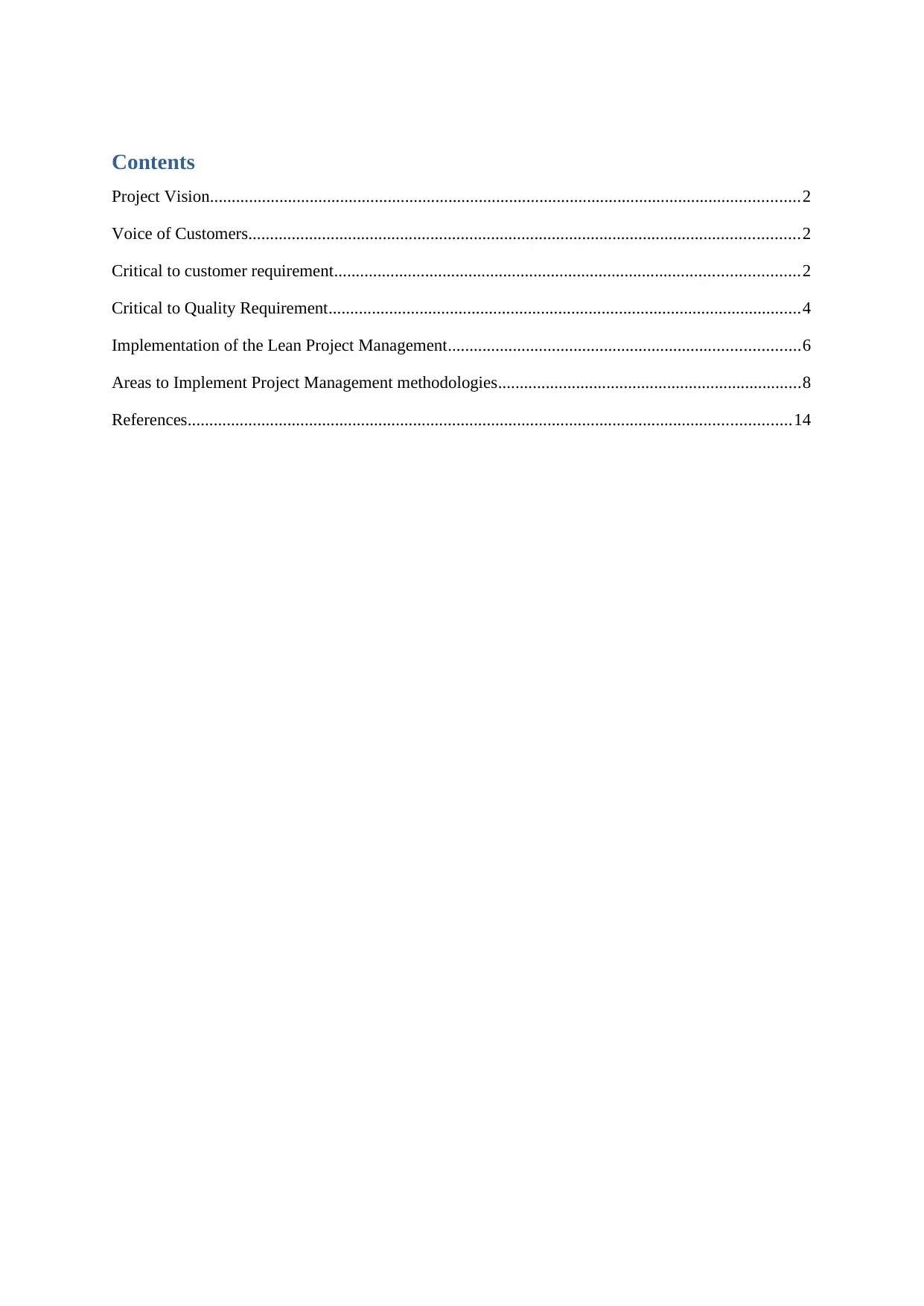
Contents
Project Vision........................................................................................................................................2
Voice of Customers...............................................................................................................................2
Critical to customer requirement...........................................................................................................2
Critical to Quality Requirement.............................................................................................................4
Implementation of the Lean Project Management.................................................................................6
Areas to Implement Project Management methodologies......................................................................8
References...........................................................................................................................................14
Project Vision........................................................................................................................................2
Voice of Customers...............................................................................................................................2
Critical to customer requirement...........................................................................................................2
Critical to Quality Requirement.............................................................................................................4
Implementation of the Lean Project Management.................................................................................6
Areas to Implement Project Management methodologies......................................................................8
References...........................................................................................................................................14
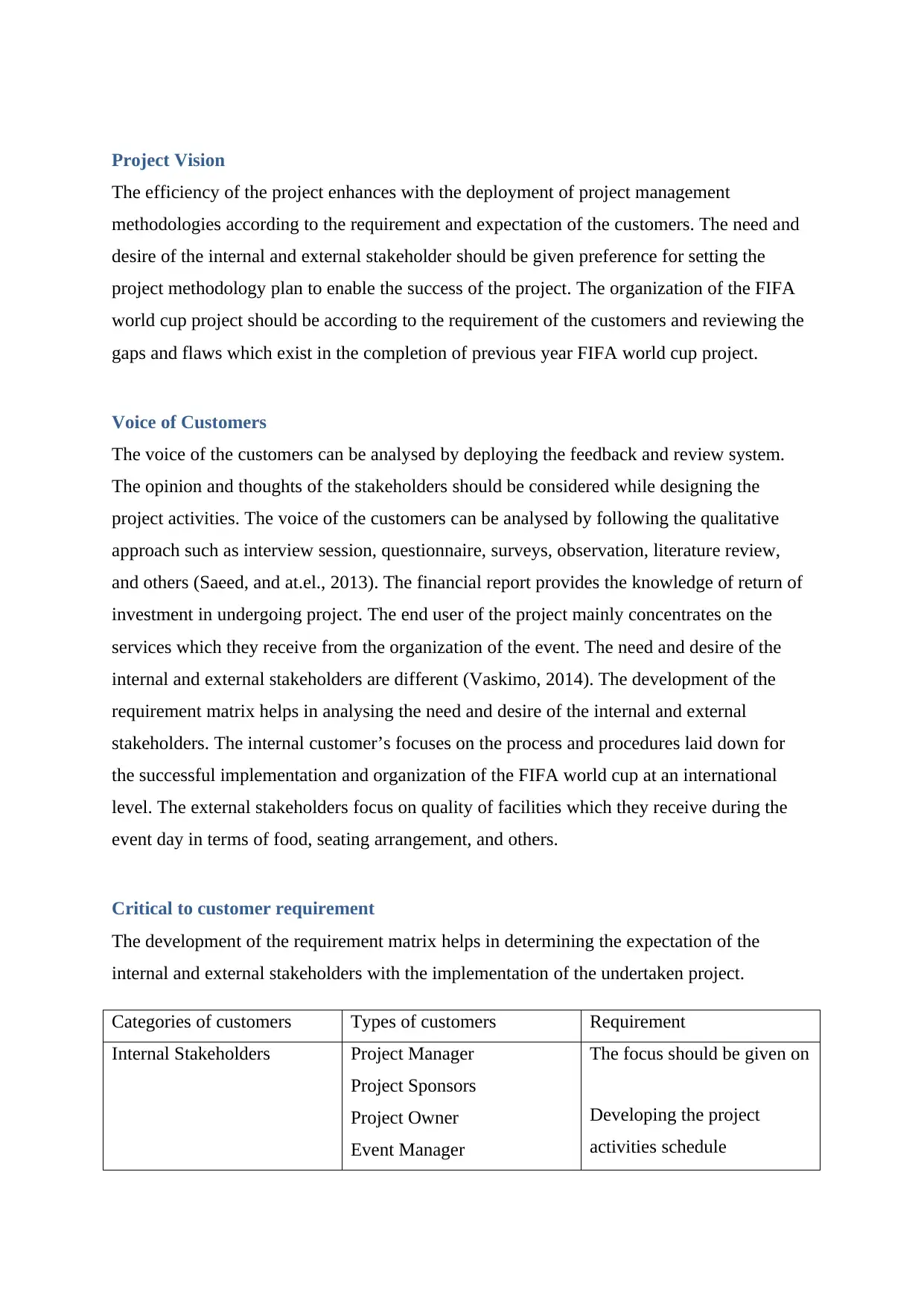
Project Vision
The efficiency of the project enhances with the deployment of project management
methodologies according to the requirement and expectation of the customers. The need and
desire of the internal and external stakeholder should be given preference for setting the
project methodology plan to enable the success of the project. The organization of the FIFA
world cup project should be according to the requirement of the customers and reviewing the
gaps and flaws which exist in the completion of previous year FIFA world cup project.
Voice of Customers
The voice of the customers can be analysed by deploying the feedback and review system.
The opinion and thoughts of the stakeholders should be considered while designing the
project activities. The voice of the customers can be analysed by following the qualitative
approach such as interview session, questionnaire, surveys, observation, literature review,
and others (Saeed, and at.el., 2013). The financial report provides the knowledge of return of
investment in undergoing project. The end user of the project mainly concentrates on the
services which they receive from the organization of the event. The need and desire of the
internal and external stakeholders are different (Vaskimo, 2014). The development of the
requirement matrix helps in analysing the need and desire of the internal and external
stakeholders. The internal customer’s focuses on the process and procedures laid down for
the successful implementation and organization of the FIFA world cup at an international
level. The external stakeholders focus on quality of facilities which they receive during the
event day in terms of food, seating arrangement, and others.
Critical to customer requirement
The development of the requirement matrix helps in determining the expectation of the
internal and external stakeholders with the implementation of the undertaken project.
Categories of customers Types of customers Requirement
Internal Stakeholders Project Manager
Project Sponsors
Project Owner
Event Manager
The focus should be given on
Developing the project
activities schedule
The efficiency of the project enhances with the deployment of project management
methodologies according to the requirement and expectation of the customers. The need and
desire of the internal and external stakeholder should be given preference for setting the
project methodology plan to enable the success of the project. The organization of the FIFA
world cup project should be according to the requirement of the customers and reviewing the
gaps and flaws which exist in the completion of previous year FIFA world cup project.
Voice of Customers
The voice of the customers can be analysed by deploying the feedback and review system.
The opinion and thoughts of the stakeholders should be considered while designing the
project activities. The voice of the customers can be analysed by following the qualitative
approach such as interview session, questionnaire, surveys, observation, literature review,
and others (Saeed, and at.el., 2013). The financial report provides the knowledge of return of
investment in undergoing project. The end user of the project mainly concentrates on the
services which they receive from the organization of the event. The need and desire of the
internal and external stakeholders are different (Vaskimo, 2014). The development of the
requirement matrix helps in analysing the need and desire of the internal and external
stakeholders. The internal customer’s focuses on the process and procedures laid down for
the successful implementation and organization of the FIFA world cup at an international
level. The external stakeholders focus on quality of facilities which they receive during the
event day in terms of food, seating arrangement, and others.
Critical to customer requirement
The development of the requirement matrix helps in determining the expectation of the
internal and external stakeholders with the implementation of the undertaken project.
Categories of customers Types of customers Requirement
Internal Stakeholders Project Manager
Project Sponsors
Project Owner
Event Manager
The focus should be given on
Developing the project
activities schedule
⊘ This is a preview!⊘
Do you want full access?
Subscribe today to unlock all pages.

Trusted by 1+ million students worldwide
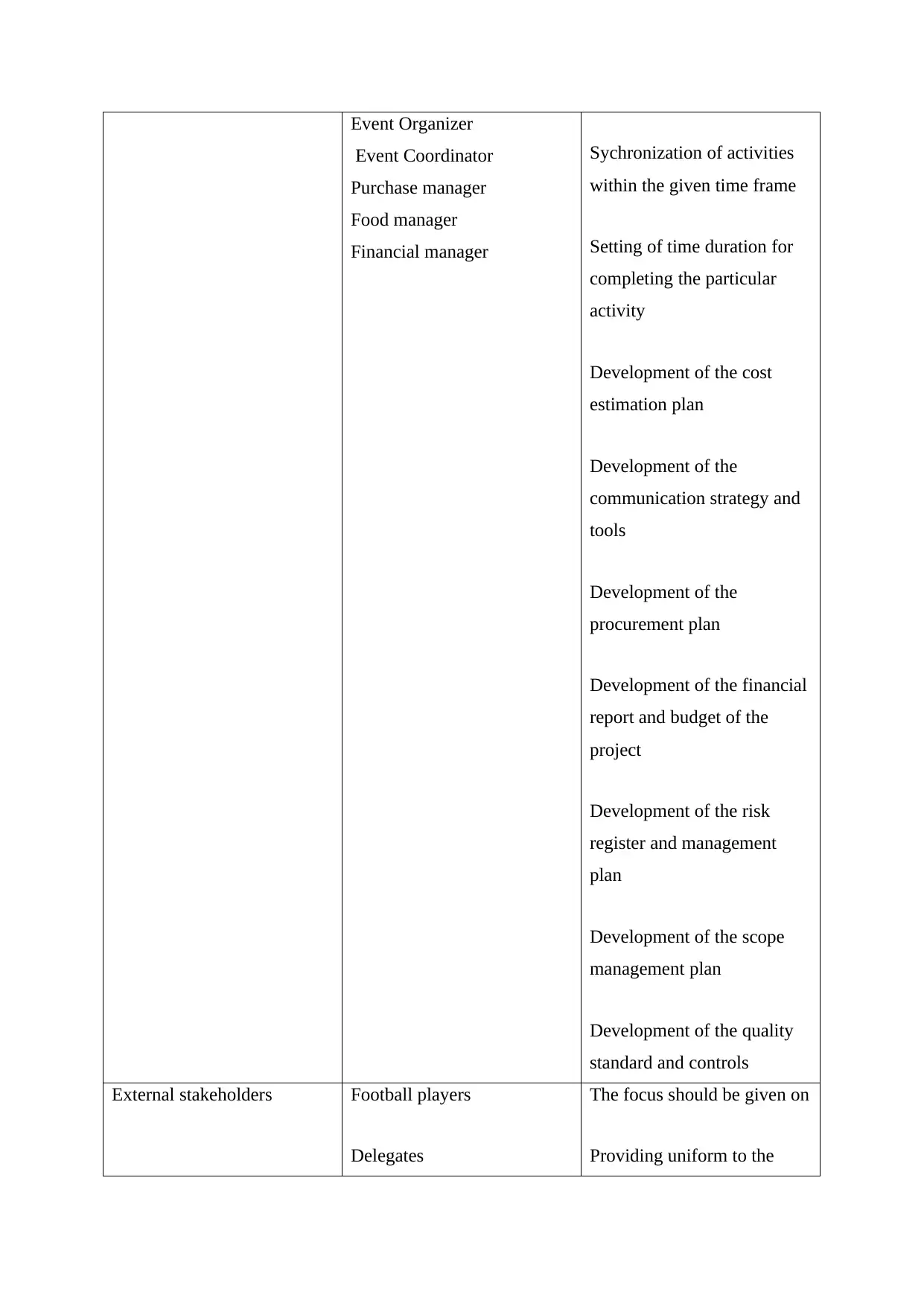
Event Organizer
Event Coordinator
Purchase manager
Food manager
Financial manager
Sychronization of activities
within the given time frame
Setting of time duration for
completing the particular
activity
Development of the cost
estimation plan
Development of the
communication strategy and
tools
Development of the
procurement plan
Development of the financial
report and budget of the
project
Development of the risk
register and management
plan
Development of the scope
management plan
Development of the quality
standard and controls
External stakeholders Football players
Delegates
The focus should be given on
Providing uniform to the
Event Coordinator
Purchase manager
Food manager
Financial manager
Sychronization of activities
within the given time frame
Setting of time duration for
completing the particular
activity
Development of the cost
estimation plan
Development of the
communication strategy and
tools
Development of the
procurement plan
Development of the financial
report and budget of the
project
Development of the risk
register and management
plan
Development of the scope
management plan
Development of the quality
standard and controls
External stakeholders Football players
Delegates
The focus should be given on
Providing uniform to the
Paraphrase This Document
Need a fresh take? Get an instant paraphrase of this document with our AI Paraphraser
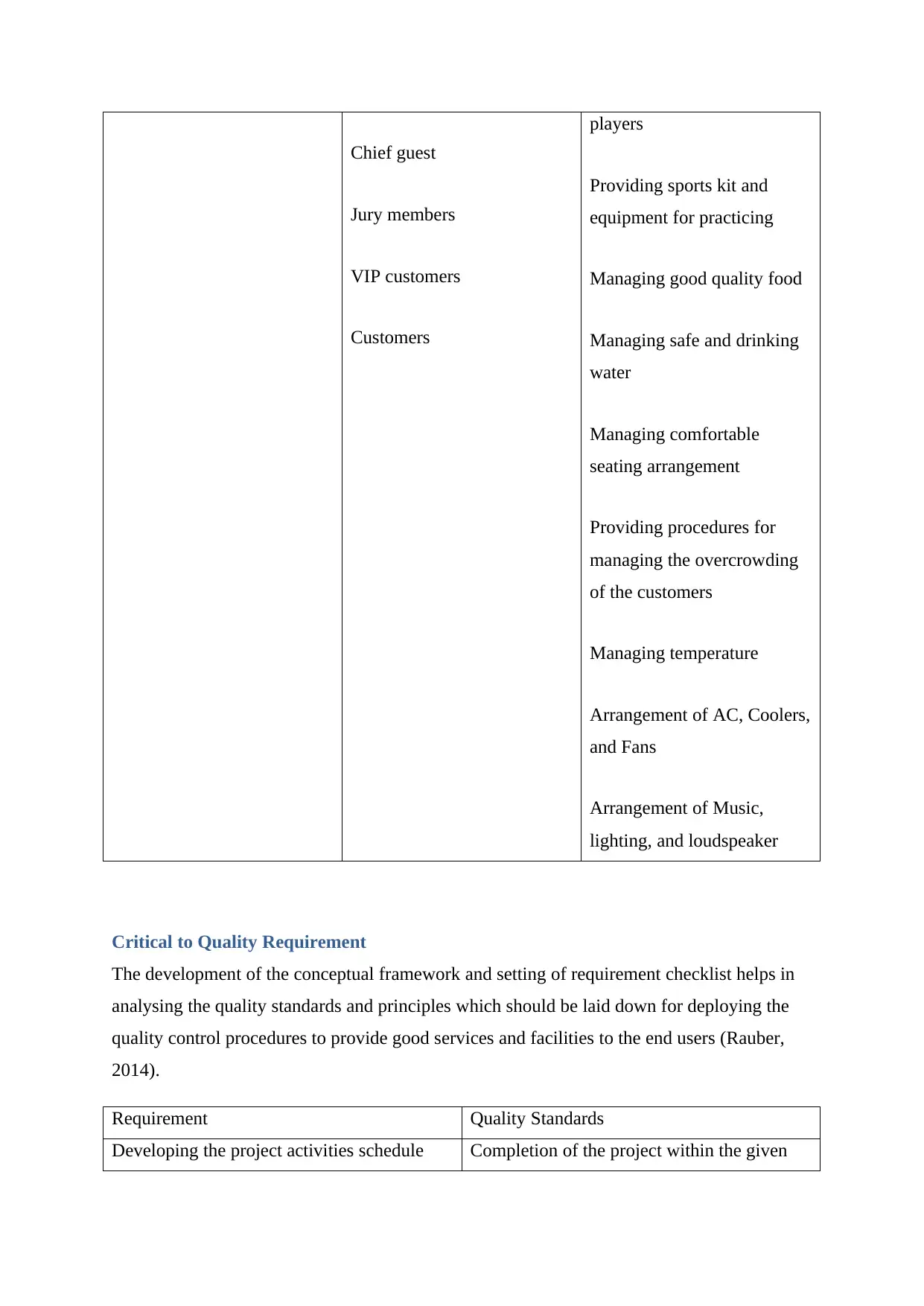
Chief guest
Jury members
VIP customers
Customers
players
Providing sports kit and
equipment for practicing
Managing good quality food
Managing safe and drinking
water
Managing comfortable
seating arrangement
Providing procedures for
managing the overcrowding
of the customers
Managing temperature
Arrangement of AC, Coolers,
and Fans
Arrangement of Music,
lighting, and loudspeaker
Critical to Quality Requirement
The development of the conceptual framework and setting of requirement checklist helps in
analysing the quality standards and principles which should be laid down for deploying the
quality control procedures to provide good services and facilities to the end users (Rauber,
2014).
Requirement Quality Standards
Developing the project activities schedule Completion of the project within the given
Jury members
VIP customers
Customers
players
Providing sports kit and
equipment for practicing
Managing good quality food
Managing safe and drinking
water
Managing comfortable
seating arrangement
Providing procedures for
managing the overcrowding
of the customers
Managing temperature
Arrangement of AC, Coolers,
and Fans
Arrangement of Music,
lighting, and loudspeaker
Critical to Quality Requirement
The development of the conceptual framework and setting of requirement checklist helps in
analysing the quality standards and principles which should be laid down for deploying the
quality control procedures to provide good services and facilities to the end users (Rauber,
2014).
Requirement Quality Standards
Developing the project activities schedule Completion of the project within the given
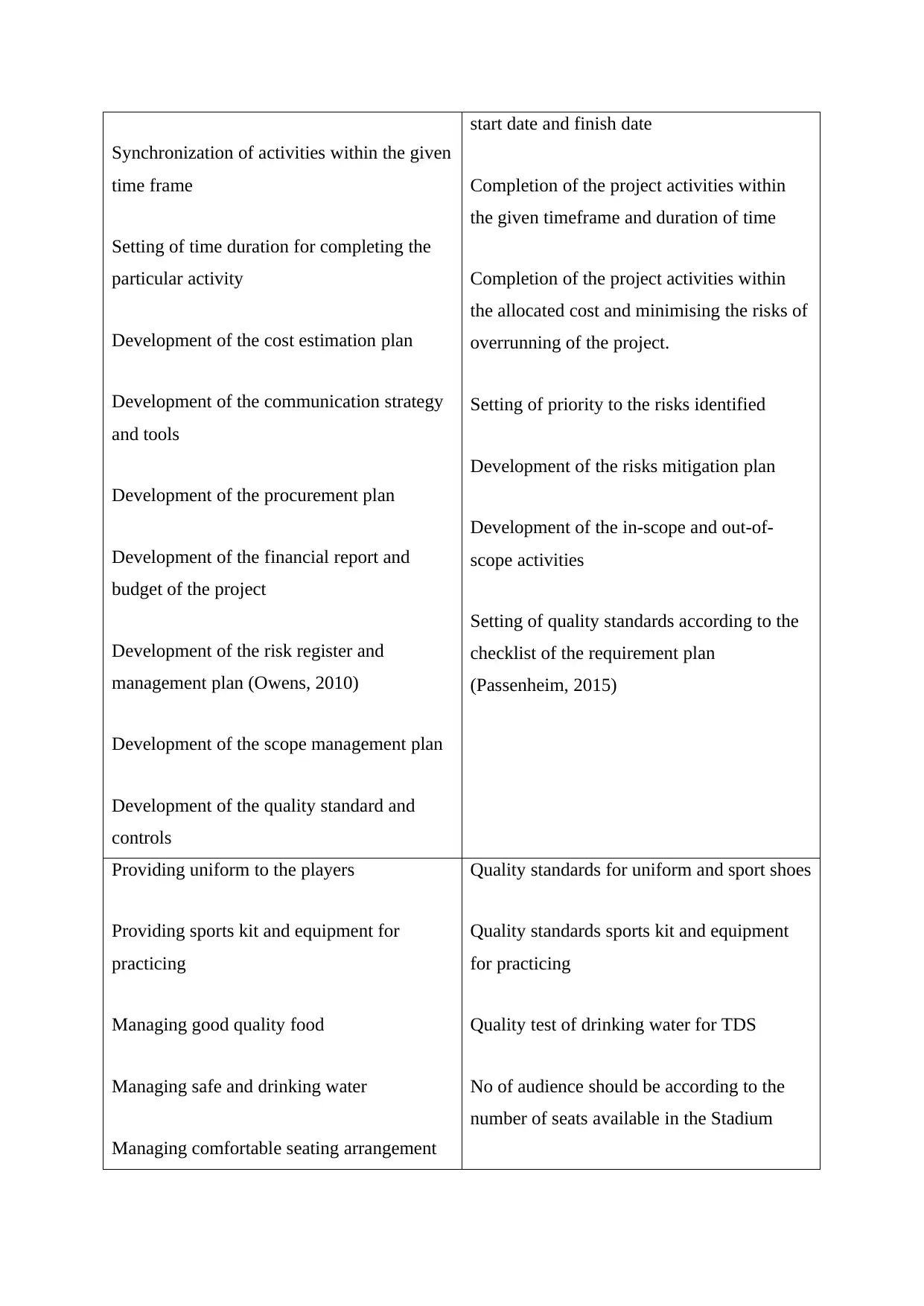
Synchronization of activities within the given
time frame
Setting of time duration for completing the
particular activity
Development of the cost estimation plan
Development of the communication strategy
and tools
Development of the procurement plan
Development of the financial report and
budget of the project
Development of the risk register and
management plan (Owens, 2010)
Development of the scope management plan
Development of the quality standard and
controls
start date and finish date
Completion of the project activities within
the given timeframe and duration of time
Completion of the project activities within
the allocated cost and minimising the risks of
overrunning of the project.
Setting of priority to the risks identified
Development of the risks mitigation plan
Development of the in-scope and out-of-
scope activities
Setting of quality standards according to the
checklist of the requirement plan
(Passenheim, 2015)
Providing uniform to the players
Providing sports kit and equipment for
practicing
Managing good quality food
Managing safe and drinking water
Managing comfortable seating arrangement
Quality standards for uniform and sport shoes
Quality standards sports kit and equipment
for practicing
Quality test of drinking water for TDS
No of audience should be according to the
number of seats available in the Stadium
time frame
Setting of time duration for completing the
particular activity
Development of the cost estimation plan
Development of the communication strategy
and tools
Development of the procurement plan
Development of the financial report and
budget of the project
Development of the risk register and
management plan (Owens, 2010)
Development of the scope management plan
Development of the quality standard and
controls
start date and finish date
Completion of the project activities within
the given timeframe and duration of time
Completion of the project activities within
the allocated cost and minimising the risks of
overrunning of the project.
Setting of priority to the risks identified
Development of the risks mitigation plan
Development of the in-scope and out-of-
scope activities
Setting of quality standards according to the
checklist of the requirement plan
(Passenheim, 2015)
Providing uniform to the players
Providing sports kit and equipment for
practicing
Managing good quality food
Managing safe and drinking water
Managing comfortable seating arrangement
Quality standards for uniform and sport shoes
Quality standards sports kit and equipment
for practicing
Quality test of drinking water for TDS
No of audience should be according to the
number of seats available in the Stadium
⊘ This is a preview!⊘
Do you want full access?
Subscribe today to unlock all pages.

Trusted by 1+ million students worldwide
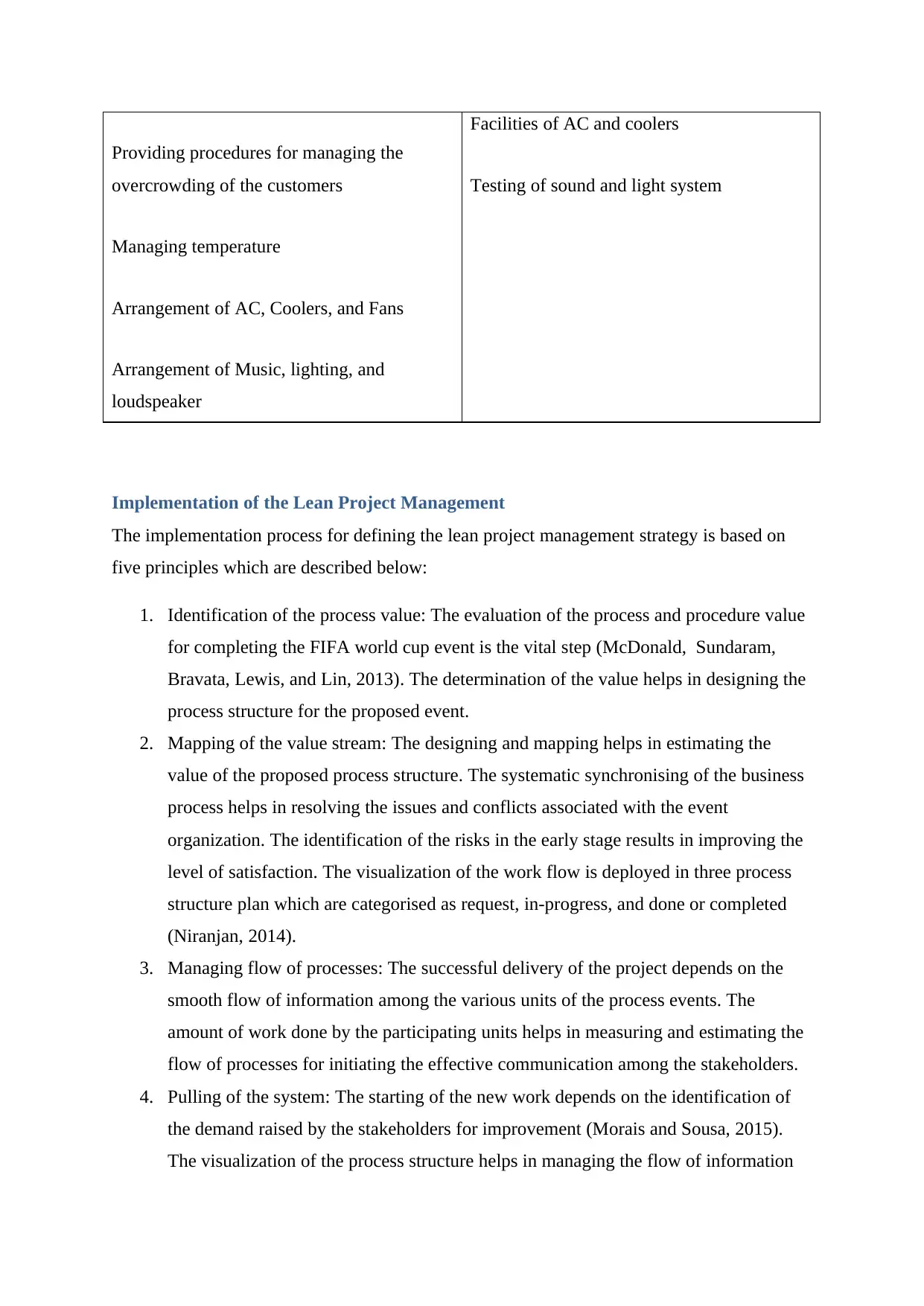
Providing procedures for managing the
overcrowding of the customers
Managing temperature
Arrangement of AC, Coolers, and Fans
Arrangement of Music, lighting, and
loudspeaker
Facilities of AC and coolers
Testing of sound and light system
Implementation of the Lean Project Management
The implementation process for defining the lean project management strategy is based on
five principles which are described below:
1. Identification of the process value: The evaluation of the process and procedure value
for completing the FIFA world cup event is the vital step (McDonald, Sundaram,
Bravata, Lewis, and Lin, 2013). The determination of the value helps in designing the
process structure for the proposed event.
2. Mapping of the value stream: The designing and mapping helps in estimating the
value of the proposed process structure. The systematic synchronising of the business
process helps in resolving the issues and conflicts associated with the event
organization. The identification of the risks in the early stage results in improving the
level of satisfaction. The visualization of the work flow is deployed in three process
structure plan which are categorised as request, in-progress, and done or completed
(Niranjan, 2014).
3. Managing flow of processes: The successful delivery of the project depends on the
smooth flow of information among the various units of the process events. The
amount of work done by the participating units helps in measuring and estimating the
flow of processes for initiating the effective communication among the stakeholders.
4. Pulling of the system: The starting of the new work depends on the identification of
the demand raised by the stakeholders for improvement (Morais and Sousa, 2015).
The visualization of the process structure helps in managing the flow of information
overcrowding of the customers
Managing temperature
Arrangement of AC, Coolers, and Fans
Arrangement of Music, lighting, and
loudspeaker
Facilities of AC and coolers
Testing of sound and light system
Implementation of the Lean Project Management
The implementation process for defining the lean project management strategy is based on
five principles which are described below:
1. Identification of the process value: The evaluation of the process and procedure value
for completing the FIFA world cup event is the vital step (McDonald, Sundaram,
Bravata, Lewis, and Lin, 2013). The determination of the value helps in designing the
process structure for the proposed event.
2. Mapping of the value stream: The designing and mapping helps in estimating the
value of the proposed process structure. The systematic synchronising of the business
process helps in resolving the issues and conflicts associated with the event
organization. The identification of the risks in the early stage results in improving the
level of satisfaction. The visualization of the work flow is deployed in three process
structure plan which are categorised as request, in-progress, and done or completed
(Niranjan, 2014).
3. Managing flow of processes: The successful delivery of the project depends on the
smooth flow of information among the various units of the process events. The
amount of work done by the participating units helps in measuring and estimating the
flow of processes for initiating the effective communication among the stakeholders.
4. Pulling of the system: The starting of the new work depends on the identification of
the demand raised by the stakeholders for improvement (Morais and Sousa, 2015).
The visualization of the process structure helps in managing the flow of information
Paraphrase This Document
Need a fresh take? Get an instant paraphrase of this document with our AI Paraphraser
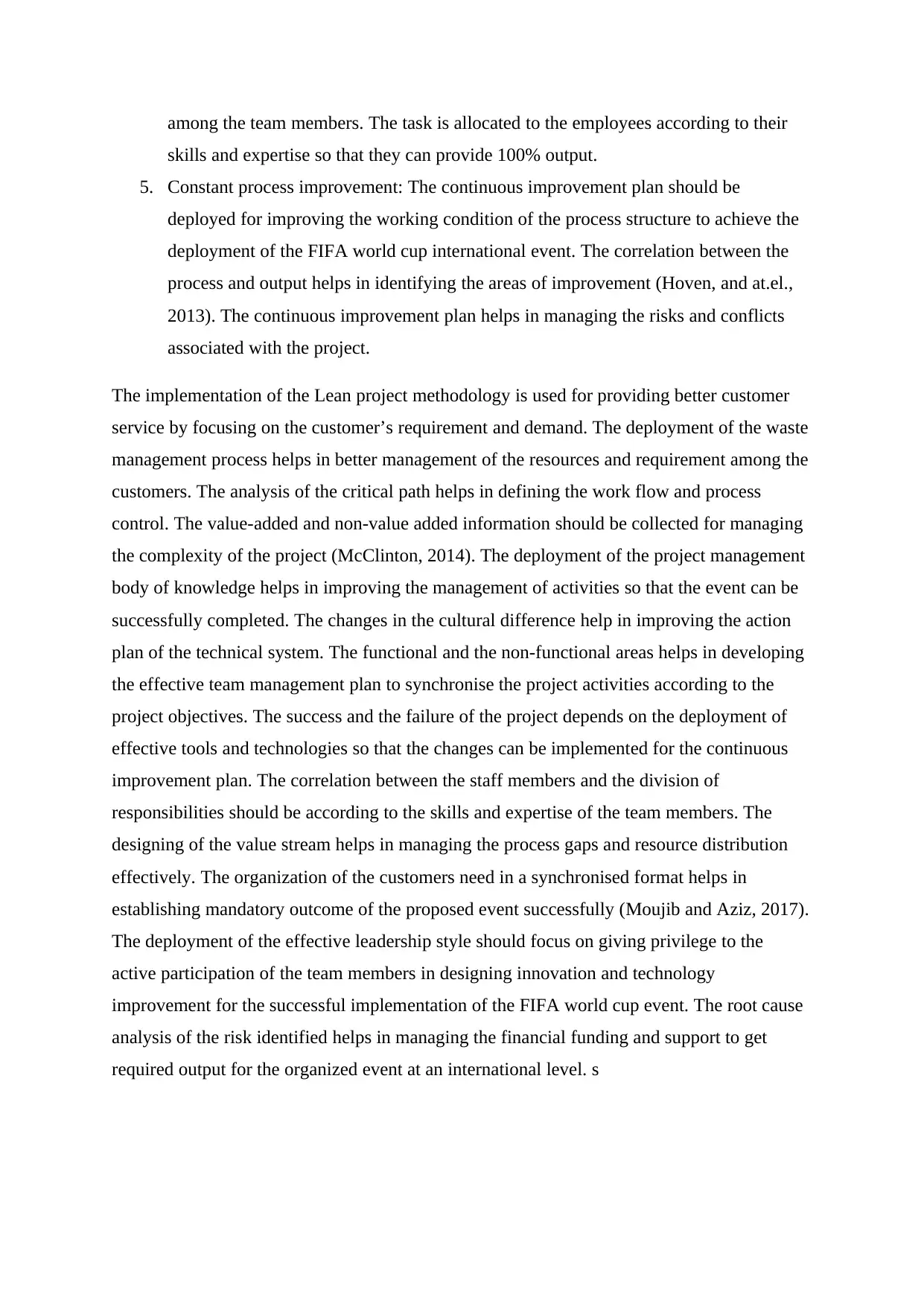
among the team members. The task is allocated to the employees according to their
skills and expertise so that they can provide 100% output.
5. Constant process improvement: The continuous improvement plan should be
deployed for improving the working condition of the process structure to achieve the
deployment of the FIFA world cup international event. The correlation between the
process and output helps in identifying the areas of improvement (Hoven, and at.el.,
2013). The continuous improvement plan helps in managing the risks and conflicts
associated with the project.
The implementation of the Lean project methodology is used for providing better customer
service by focusing on the customer’s requirement and demand. The deployment of the waste
management process helps in better management of the resources and requirement among the
customers. The analysis of the critical path helps in defining the work flow and process
control. The value-added and non-value added information should be collected for managing
the complexity of the project (McClinton, 2014). The deployment of the project management
body of knowledge helps in improving the management of activities so that the event can be
successfully completed. The changes in the cultural difference help in improving the action
plan of the technical system. The functional and the non-functional areas helps in developing
the effective team management plan to synchronise the project activities according to the
project objectives. The success and the failure of the project depends on the deployment of
effective tools and technologies so that the changes can be implemented for the continuous
improvement plan. The correlation between the staff members and the division of
responsibilities should be according to the skills and expertise of the team members. The
designing of the value stream helps in managing the process gaps and resource distribution
effectively. The organization of the customers need in a synchronised format helps in
establishing mandatory outcome of the proposed event successfully (Moujib and Aziz, 2017).
The deployment of the effective leadership style should focus on giving privilege to the
active participation of the team members in designing innovation and technology
improvement for the successful implementation of the FIFA world cup event. The root cause
analysis of the risk identified helps in managing the financial funding and support to get
required output for the organized event at an international level. s
skills and expertise so that they can provide 100% output.
5. Constant process improvement: The continuous improvement plan should be
deployed for improving the working condition of the process structure to achieve the
deployment of the FIFA world cup international event. The correlation between the
process and output helps in identifying the areas of improvement (Hoven, and at.el.,
2013). The continuous improvement plan helps in managing the risks and conflicts
associated with the project.
The implementation of the Lean project methodology is used for providing better customer
service by focusing on the customer’s requirement and demand. The deployment of the waste
management process helps in better management of the resources and requirement among the
customers. The analysis of the critical path helps in defining the work flow and process
control. The value-added and non-value added information should be collected for managing
the complexity of the project (McClinton, 2014). The deployment of the project management
body of knowledge helps in improving the management of activities so that the event can be
successfully completed. The changes in the cultural difference help in improving the action
plan of the technical system. The functional and the non-functional areas helps in developing
the effective team management plan to synchronise the project activities according to the
project objectives. The success and the failure of the project depends on the deployment of
effective tools and technologies so that the changes can be implemented for the continuous
improvement plan. The correlation between the staff members and the division of
responsibilities should be according to the skills and expertise of the team members. The
designing of the value stream helps in managing the process gaps and resource distribution
effectively. The organization of the customers need in a synchronised format helps in
establishing mandatory outcome of the proposed event successfully (Moujib and Aziz, 2017).
The deployment of the effective leadership style should focus on giving privilege to the
active participation of the team members in designing innovation and technology
improvement for the successful implementation of the FIFA world cup event. The root cause
analysis of the risk identified helps in managing the financial funding and support to get
required output for the organized event at an international level. s
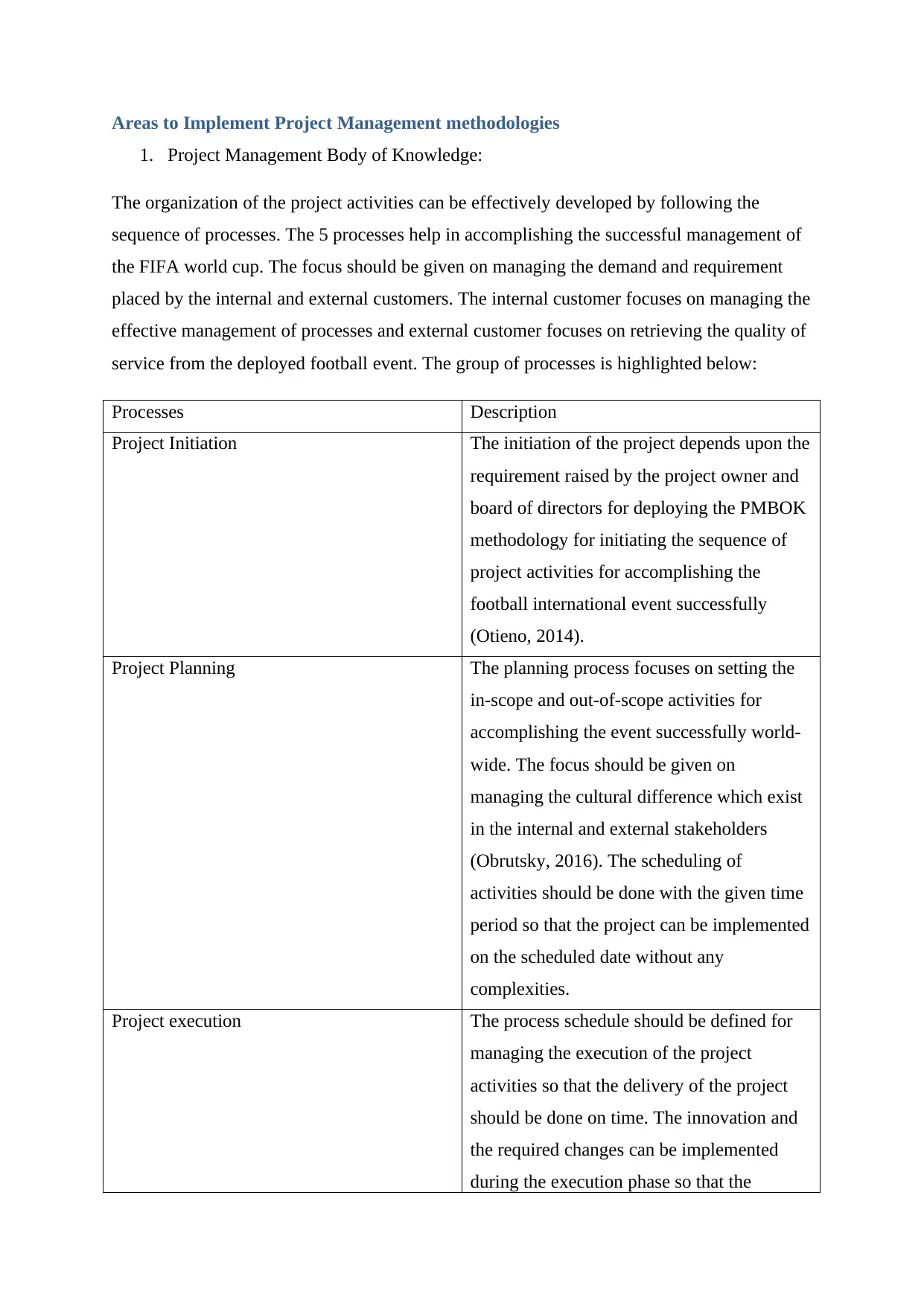
Areas to Implement Project Management methodologies
1. Project Management Body of Knowledge:
The organization of the project activities can be effectively developed by following the
sequence of processes. The 5 processes help in accomplishing the successful management of
the FIFA world cup. The focus should be given on managing the demand and requirement
placed by the internal and external customers. The internal customer focuses on managing the
effective management of processes and external customer focuses on retrieving the quality of
service from the deployed football event. The group of processes is highlighted below:
Processes Description
Project Initiation The initiation of the project depends upon the
requirement raised by the project owner and
board of directors for deploying the PMBOK
methodology for initiating the sequence of
project activities for accomplishing the
football international event successfully
(Otieno, 2014).
Project Planning The planning process focuses on setting the
in-scope and out-of-scope activities for
accomplishing the event successfully world-
wide. The focus should be given on
managing the cultural difference which exist
in the internal and external stakeholders
(Obrutsky, 2016). The scheduling of
activities should be done with the given time
period so that the project can be implemented
on the scheduled date without any
complexities.
Project execution The process schedule should be defined for
managing the execution of the project
activities so that the delivery of the project
should be done on time. The innovation and
the required changes can be implemented
during the execution phase so that the
1. Project Management Body of Knowledge:
The organization of the project activities can be effectively developed by following the
sequence of processes. The 5 processes help in accomplishing the successful management of
the FIFA world cup. The focus should be given on managing the demand and requirement
placed by the internal and external customers. The internal customer focuses on managing the
effective management of processes and external customer focuses on retrieving the quality of
service from the deployed football event. The group of processes is highlighted below:
Processes Description
Project Initiation The initiation of the project depends upon the
requirement raised by the project owner and
board of directors for deploying the PMBOK
methodology for initiating the sequence of
project activities for accomplishing the
football international event successfully
(Otieno, 2014).
Project Planning The planning process focuses on setting the
in-scope and out-of-scope activities for
accomplishing the event successfully world-
wide. The focus should be given on
managing the cultural difference which exist
in the internal and external stakeholders
(Obrutsky, 2016). The scheduling of
activities should be done with the given time
period so that the project can be implemented
on the scheduled date without any
complexities.
Project execution The process schedule should be defined for
managing the execution of the project
activities so that the delivery of the project
should be done on time. The innovation and
the required changes can be implemented
during the execution phase so that the
⊘ This is a preview!⊘
Do you want full access?
Subscribe today to unlock all pages.

Trusted by 1+ million students worldwide
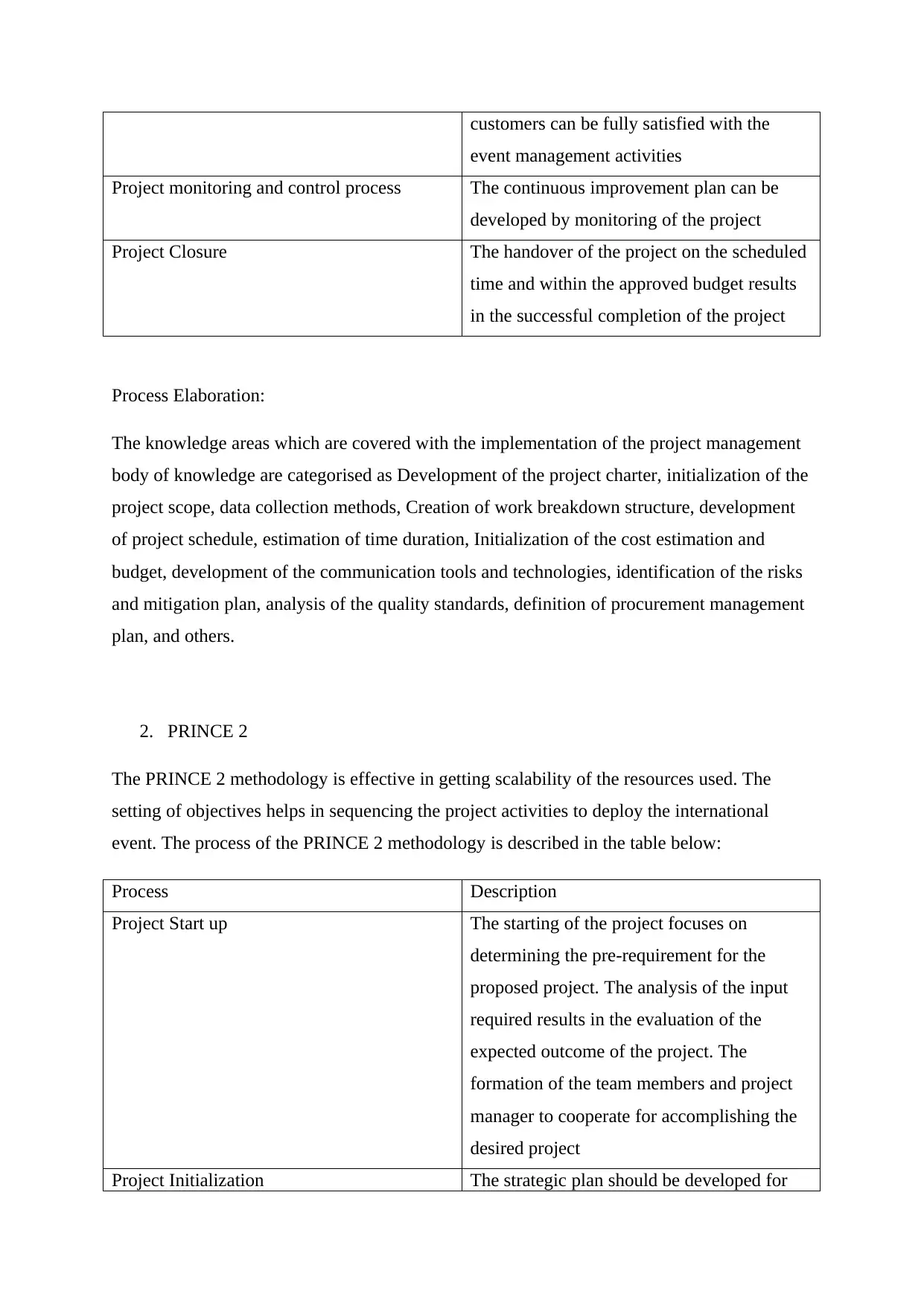
customers can be fully satisfied with the
event management activities
Project monitoring and control process The continuous improvement plan can be
developed by monitoring of the project
Project Closure The handover of the project on the scheduled
time and within the approved budget results
in the successful completion of the project
Process Elaboration:
The knowledge areas which are covered with the implementation of the project management
body of knowledge are categorised as Development of the project charter, initialization of the
project scope, data collection methods, Creation of work breakdown structure, development
of project schedule, estimation of time duration, Initialization of the cost estimation and
budget, development of the communication tools and technologies, identification of the risks
and mitigation plan, analysis of the quality standards, definition of procurement management
plan, and others.
2. PRINCE 2
The PRINCE 2 methodology is effective in getting scalability of the resources used. The
setting of objectives helps in sequencing the project activities to deploy the international
event. The process of the PRINCE 2 methodology is described in the table below:
Process Description
Project Start up The starting of the project focuses on
determining the pre-requirement for the
proposed project. The analysis of the input
required results in the evaluation of the
expected outcome of the project. The
formation of the team members and project
manager to cooperate for accomplishing the
desired project
Project Initialization The strategic plan should be developed for
event management activities
Project monitoring and control process The continuous improvement plan can be
developed by monitoring of the project
Project Closure The handover of the project on the scheduled
time and within the approved budget results
in the successful completion of the project
Process Elaboration:
The knowledge areas which are covered with the implementation of the project management
body of knowledge are categorised as Development of the project charter, initialization of the
project scope, data collection methods, Creation of work breakdown structure, development
of project schedule, estimation of time duration, Initialization of the cost estimation and
budget, development of the communication tools and technologies, identification of the risks
and mitigation plan, analysis of the quality standards, definition of procurement management
plan, and others.
2. PRINCE 2
The PRINCE 2 methodology is effective in getting scalability of the resources used. The
setting of objectives helps in sequencing the project activities to deploy the international
event. The process of the PRINCE 2 methodology is described in the table below:
Process Description
Project Start up The starting of the project focuses on
determining the pre-requirement for the
proposed project. The analysis of the input
required results in the evaluation of the
expected outcome of the project. The
formation of the team members and project
manager to cooperate for accomplishing the
desired project
Project Initialization The strategic plan should be developed for
Paraphrase This Document
Need a fresh take? Get an instant paraphrase of this document with our AI Paraphraser
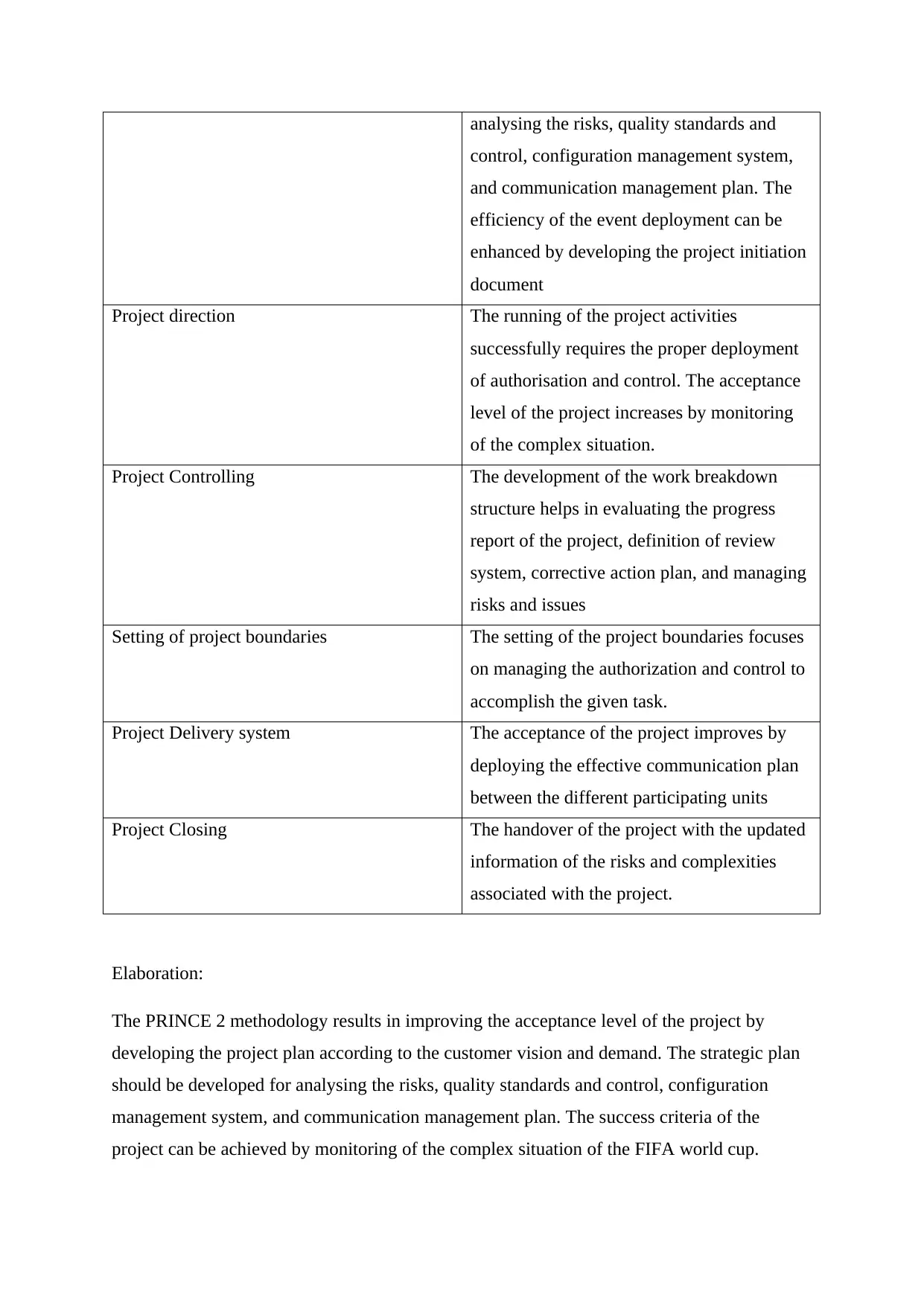
analysing the risks, quality standards and
control, configuration management system,
and communication management plan. The
efficiency of the event deployment can be
enhanced by developing the project initiation
document
Project direction The running of the project activities
successfully requires the proper deployment
of authorisation and control. The acceptance
level of the project increases by monitoring
of the complex situation.
Project Controlling The development of the work breakdown
structure helps in evaluating the progress
report of the project, definition of review
system, corrective action plan, and managing
risks and issues
Setting of project boundaries The setting of the project boundaries focuses
on managing the authorization and control to
accomplish the given task.
Project Delivery system The acceptance of the project improves by
deploying the effective communication plan
between the different participating units
Project Closing The handover of the project with the updated
information of the risks and complexities
associated with the project.
Elaboration:
The PRINCE 2 methodology results in improving the acceptance level of the project by
developing the project plan according to the customer vision and demand. The strategic plan
should be developed for analysing the risks, quality standards and control, configuration
management system, and communication management plan. The success criteria of the
project can be achieved by monitoring of the complex situation of the FIFA world cup.
control, configuration management system,
and communication management plan. The
efficiency of the event deployment can be
enhanced by developing the project initiation
document
Project direction The running of the project activities
successfully requires the proper deployment
of authorisation and control. The acceptance
level of the project increases by monitoring
of the complex situation.
Project Controlling The development of the work breakdown
structure helps in evaluating the progress
report of the project, definition of review
system, corrective action plan, and managing
risks and issues
Setting of project boundaries The setting of the project boundaries focuses
on managing the authorization and control to
accomplish the given task.
Project Delivery system The acceptance of the project improves by
deploying the effective communication plan
between the different participating units
Project Closing The handover of the project with the updated
information of the risks and complexities
associated with the project.
Elaboration:
The PRINCE 2 methodology results in improving the acceptance level of the project by
developing the project plan according to the customer vision and demand. The strategic plan
should be developed for analysing the risks, quality standards and control, configuration
management system, and communication management plan. The success criteria of the
project can be achieved by monitoring of the complex situation of the FIFA world cup.
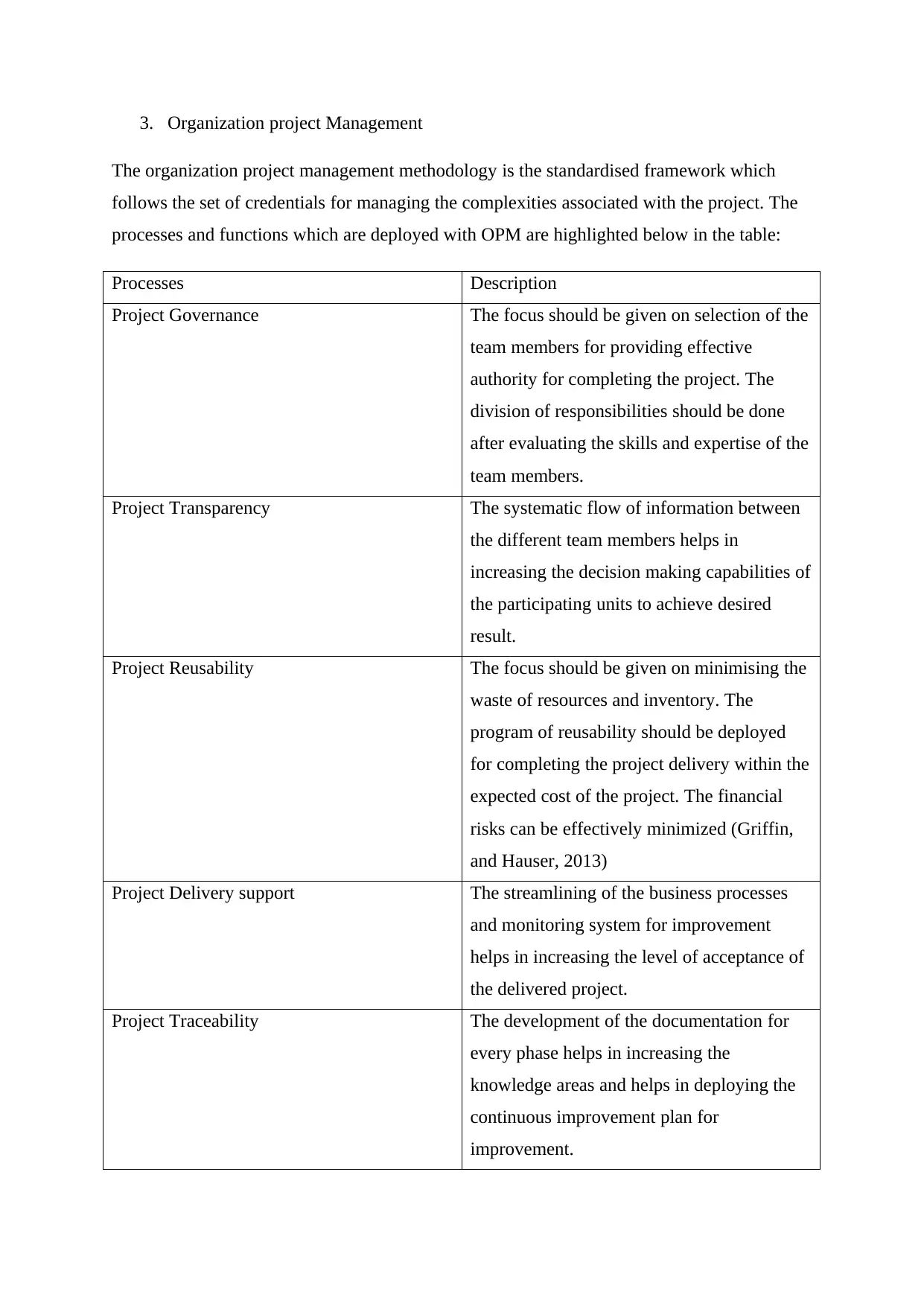
3. Organization project Management
The organization project management methodology is the standardised framework which
follows the set of credentials for managing the complexities associated with the project. The
processes and functions which are deployed with OPM are highlighted below in the table:
Processes Description
Project Governance The focus should be given on selection of the
team members for providing effective
authority for completing the project. The
division of responsibilities should be done
after evaluating the skills and expertise of the
team members.
Project Transparency The systematic flow of information between
the different team members helps in
increasing the decision making capabilities of
the participating units to achieve desired
result.
Project Reusability The focus should be given on minimising the
waste of resources and inventory. The
program of reusability should be deployed
for completing the project delivery within the
expected cost of the project. The financial
risks can be effectively minimized (Griffin,
and Hauser, 2013)
Project Delivery support The streamlining of the business processes
and monitoring system for improvement
helps in increasing the level of acceptance of
the delivered project.
Project Traceability The development of the documentation for
every phase helps in increasing the
knowledge areas and helps in deploying the
continuous improvement plan for
improvement.
The organization project management methodology is the standardised framework which
follows the set of credentials for managing the complexities associated with the project. The
processes and functions which are deployed with OPM are highlighted below in the table:
Processes Description
Project Governance The focus should be given on selection of the
team members for providing effective
authority for completing the project. The
division of responsibilities should be done
after evaluating the skills and expertise of the
team members.
Project Transparency The systematic flow of information between
the different team members helps in
increasing the decision making capabilities of
the participating units to achieve desired
result.
Project Reusability The focus should be given on minimising the
waste of resources and inventory. The
program of reusability should be deployed
for completing the project delivery within the
expected cost of the project. The financial
risks can be effectively minimized (Griffin,
and Hauser, 2013)
Project Delivery support The streamlining of the business processes
and monitoring system for improvement
helps in increasing the level of acceptance of
the delivered project.
Project Traceability The development of the documentation for
every phase helps in increasing the
knowledge areas and helps in deploying the
continuous improvement plan for
improvement.
⊘ This is a preview!⊘
Do you want full access?
Subscribe today to unlock all pages.

Trusted by 1+ million students worldwide
1 out of 17
Related Documents
Your All-in-One AI-Powered Toolkit for Academic Success.
+13062052269
info@desklib.com
Available 24*7 on WhatsApp / Email
![[object Object]](/_next/static/media/star-bottom.7253800d.svg)
Unlock your academic potential
Copyright © 2020–2025 A2Z Services. All Rights Reserved. Developed and managed by ZUCOL.
